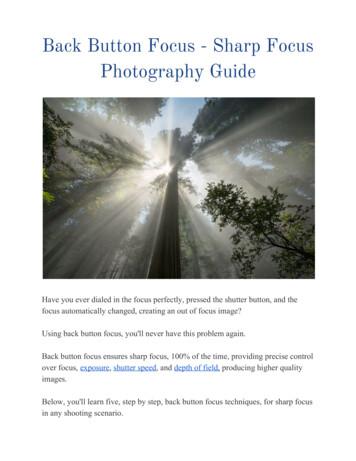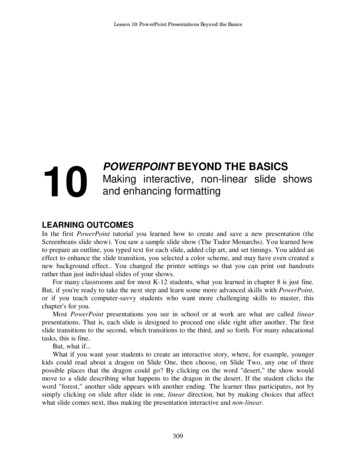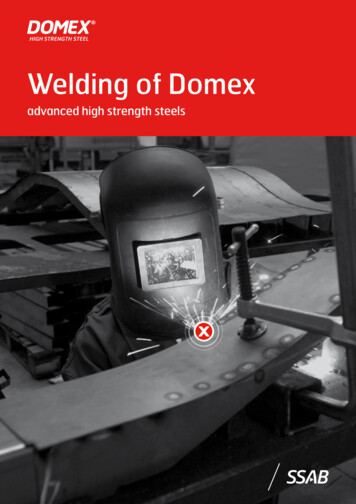
Transcription
Back Button Focus - Sharp FocusPhotography GuideHave you ever dialed in the focus perfectly, pressed the shutter button, and thefocus automatically changed, creating an out of focus image?Using back button focus, you'll never have this problem again.Back button focus ensures sharp focus, 100% of the time, providing precise controlover focus, exposure , shutter speed , and depth of field, producing higher qualityimages.Below, you'll learn five, step by step, back button focus techniques, for sharp focusin any shooting scenario.
www.DaveMorrowPhotography.com Page 2Table of ContentsTable of Contents2Back Button Focus Video & Camera Technique3Back Button Focus - Why You Need It3Benefits of Back Button Focus4Problems with Shutter Button Autofocus5Problem 1: Unwanted Change in Focal Point, Exposure Settings & Metering5Problem 2: Delay in High-Speed Continuous Shooting7Focal Point & Focal Range BasicsThe Best Autofocus Settings for Landscape PhotographyOverview of this SectionFocus Method 1: Hyperfocal Distance Technique9121516How to Find the Hyperfocal Distance - Step by Step20Caveats to this Focusing Method21Why Not Shoot at f/16 or f/22?22Why Not Use a Hyperfocal Distance App?22Focus Method 2: One Third Focal PointCaveats to this Focusing MethodFocus Method 3: Direct Center Focal PointCaveats to this Focusing MethodFocus Method 4: Single Subject Focal PointCaveats to this Method of Focusing232525272728Focus Method 5: Focus Stacking & Back Button Focus29Closing Comments31Useful Links & InformationStart Here Learn Photography V iew Photos Workshops & Tours31
www.DaveMorrowPhotography.com Page 3Back Button Focus Video & CameraTechniqueBoth of the following videos teach my back button focus techniques for sharpimages.Watch them in order, then scroll down & read the guide.https://www.youtube.com/watch?v vQDhOWcy6f0https://www.youtube.com/watch?v Jqyh ijbVZcBack Button Focus - Why You Need ItOut of the box, cameras control autofocus using the shutter button, which alsotakes the image.When the autofocus button and the shutter button are one and the same, thecamera has to guess between two choices.Should it:1. Take the photo?2. Focus on the subject?The camera’s guess is often incorrect leading to out of focus images & incorrectsettings.Moving the autofocus button to the back of the camera removes this guessworkgiving the photographer complete control & sharper images on a consistent basis.Start Here Learn Photography V iew Photos Workshops & Tours
www.DaveMorrowPhotography.com Page 4Now, the photographer can control focus with a single button and take the imagewith a single button.Benefits of Back Button FocusEach important camera setting should be controlled by a single button, nomore .This way the camera never has to guess why you're pushing a specific button.Here are the main benefits of back button focus. Each is described in more detaillower on this page.1. Photographer has complete control of focal point location and focus prior totaking the image.2. Photographer has complete control over metering prior to taking the image.3. Photographer has complete control over exposure triangle settings prior totaking the image.4. The camera never guesses what the photographer wants.5. Photographer has complete control over the camera & lens.When the photographer wants to focus, they press the back button.When the photographer wants to capture an image, they press the shutter button.It's that simple.Let's discuss.Start Here Learn Photography V iew Photos Workshops & Tours
www.DaveMorrowPhotography.com Page 5Back button focus was used to capture this shot, handheld, on an 8-day mountainexpedition.Problems with Shutter Button AutofocusHere are some of the problems produced by having the autofocus button assignedto the shutter button.These are the main reasons to start using back button focus.Problem 1: Unwanted Change in Focal Point, ExposureSettings & MeteringUsing the shutter button to focus often produces the incorrect focal point,exposure/image brightness, and shutter speed, rending the image useless.Start Here Learn Photography V iew Photos Workshops & Tours
www.DaveMorrowPhotography.com Page 6Here’s an Example:After selecting the correct settings, f-stop, shutter speed, ISO, and focus, thephotographer reviews the image, prior to pressing the shutter button.When pressing the shutter button, the camera tries to refocus and meter the amountof light in the scene.Although both tasks have already been accomplished by the photographer,the camera has no way of knowing this.Without the photographer being able to review these newly selected settings, thecamera captures the image.Since the camera was guessing at the new settings, without the photographer's finalreview, the image was out of focus with the incorrect focal point and exposure.None of these problems exist using back button focus.After selecting the correct focal point, using the back button, the photographerselects the exposure settings & presses the shutter button.The shutter button takes the image, nothing more, nothing less.The results are sharp focus and the correct exposure settings, consistently.Start Here Learn Photography V iew Photos Workshops & Tours
www.DaveMorrowPhotography.com Page 7Captured using back button focus & a tripod to ensure sharp focus.Problem 2: Delay in High-Speed Continuous ShootingWhen the autofocus button and shutter button are one and the same the cameramay not take the photo at the precise moment the shutter button is pressed.At times, when the photographer wants to take a large number of photos, quickly,in sequence, as often happens in wildlife or nature photography, the camera maynot take the image.Instead of taking the image, the camera tries to refocus, delaying the image.The photographer, in turn, misses the shot.Start Here Learn Photography V iew Photos Workshops & Tours
www.DaveMorrowPhotography.com Page 8Here’s an Example:The photographer has selected the perfect focus, exposure settings and focal pointwithin the scene, preparing to take an image of birds flying by very quickly. The shutter button must take the image the instant it’s pressed or the birdswill be gone. The camera doesn’t know if the photographer is trying to take the image orfocus on the birds. The photographer knows he/she is ready to take the image but the cameradoes not.The camera guesses and tries to focus on the birds, therefore it does not take theimage the instant the shutter button is pressed.It may try to refocus, for seconds, missing the shot entirely.When holding the shutter button down to take a series of images, in quicksuccession, the camera may or may not try to refocus each time. It’s a guess! The photographer knew the image was in focus and only wanted to capturethe shot. There was no way to communicate this to the camera so it guessed & tried torefocus.By moving the autofocus button to the back button, the camera no longerdelays or tries to focus when the shutter button is pressed.The camera knows that the photographer will control the focus with the backbutton so it takes the shot at the precise moment the shutter button is pressed. The autofocus button should be placed on the back of the camera, preferablyaccessed by the right thumb. The shutter button should only take the photo.Start Here Learn Photography V iew Photos Workshops & Tours
www.DaveMorrowPhotography.com Page 9Focal Point & Focal Range BasicsSupplemental Knowledge for This Section: F-Stop & Depth of Field PhotographyGuideLandscape & outdoor photographers require the ultimate control over their camera,lens, and settings, at all times.They depend on their eyes for focus & the histogram to determine the correctexposure triangle settings.Autofocus is a great tool for landscape photographers, given that it is set upcorrectly, and used in the correct situations.Autofocus SHOULD NEVER be allowed to guess the photographers desiredfocal point within the composition.The focal point is a single point within the composition where the lens is perfectlyfocused, denoted by the red box in the graphic below.The following image was taken at f/2.8, which produces a very short focal range,to enhance your understanding.Start Here Learn Photography V iew Photos Workshops & Tours
www.DaveMorrowPhotography.com Page 10The focal range extends in front of and behind the focal point as denoted by the redlines in the graphic above.Focal range can also be denoted as depth of field.The extent of this focal range is determined by the lens focal length and f-stopsettings. As the f-stop number increases the focal range also increases, extendingfurther and further in front of and in back of the focal point. As the focal point moves forward or backward within the image, the focalrange also moves to match.The first image above shows a focal point which was selected very close to thebottom of the image.The focal range extends in front of and beyond the focal point.Start Here Learn Photography V iew Photos Workshops & Tours
www.DaveMorrowPhotography.com Page 11In the following image, all exposure settings remain the same.The focal point (red box) was shifted into the middle of the image, moving thefocal range.The last image shows a new focal point (red box) moved even further back in theimage.Start Here Learn Photography V iew Photos Workshops & Tours
www.DaveMorrowPhotography.com Page 12The photographer's goal is to select the correct combination of focal point locationand f-stop settings to produce a sharp image, as taught below.Next, you’ll learn the best autofocus settings for selecting the correct focal pointwithin the image.The Best Autofocus Settings for LandscapePhotographySome autofocus settings allow the camera to guess the photographer’s desiredfocal point within the scene.Allowing the camera to guess never provides optimal results on a consistent basis.Start Here Learn Photography V iew Photos Workshops & Tours
www.DaveMorrowPhotography.com Page 13Single point spot focus is the best autofocus setting for landscape & outdoorphotographers.Depending on your camera this may be called single point focus, spot focus, or acombination of both.Nikon Denotes this as AF-S with the Setting "S".A google search of your camera model and "single point autofocus" will pointyou in the right direction for setting up your camera.I'll use the words single point focus, or single point spot focus, interchangeably inthis guide.As long as the following paragraph holds true, the words used to describe thefunctionality don’t matter. Single point spot focus allows the photographer to choose a single locationfor the desired focal point within the composition, as shown by the small redbox in the graphic below. The photographer can choose exactly where this single focus point lieswithin the composition using the directional pad on the camera. Upon selection, this focal point will not move until directed to do so by thephotographer.In the graphic below, the red lines above and below the focal point (red box)denote the approximate extent of the focal range. This example was shot at f/11.Start Here Learn Photography V iew Photos Workshops & Tours
www.DaveMorrowPhotography.com Page 14The goal is to optimize the focal point’s location within the image so the focalrange extends from foreground to background, keeping everything in focus.1. Upon selecting the focal point, back button autofocus is used to focus thelens on this selected focal point.2. After completion of back button autofocus the photographer double checksto make sure the image is sharp.3. Manual adjustments to the focal ring can be made if the image isn’t perfectlyin focus.4. The focal point will not move unless the photographer determines that itshould.5. Therefore the photographer must know the optimal location for this focalpoint within the image.In the following section, you will learn to select the correct focal point for anycomposition, providing sharply focused images.Start Here Learn Photography V iew Photos Workshops & Tours
www.DaveMorrowPhotography.com Page 15Overview of this Section Single point spot focus should be used for landscape & outdoorphotography. Never allow autofocus to determine your focal point. The focal point should always be selected by the photographer. The photographer must know where the optimal focal point lies for anygiven composition. (Taught below) Upon selecting the focal point, back button autofocus can be used to provideinitial focus. Upon focusing at the selected focal point using autofocus the photographermust zoom in and verify that this focal point is in focus. (Reference firstvideo above)Back button focus & a tripod were used to capture this image in the forest. Start Here Learn Photography V iew Photos Workshops & Tours
www.DaveMorrowPhotography.com Page 16Focus Method 1: Hyperfocal DistanceTechniqueBack button focus is used to initiate and refine each of the following focusingmethods.Approximate Focal Length Range: 10mm - 100mm (full frame equivalent)Shooting Scenarios: Landscape & nature photography scenes shot with wideangle and zoom lenses.Hyperfocal distance is the closest point, within the composition, on which thephotographer can focus, where the entire composition beyond that point maintainssharp focus.Half the distance from this focal point, back towards the camera will also be infocus.The focus will linearly decrease from that halfway point until it reaches the bottomof the composition.Technically, Hyperfocal Distance is the most efficient focal point within thecomposition.In the graphic below the hyperfocal distance was selected, then a single point spotfocus (red box) was used to focus directly on this hyperfocal point.The focal range is shown between the red horizontal lines.Start Here Learn Photography V iew Photos Workshops & Tours
www.DaveMorrowPhotography.com Page 17The focal range above extends from the close foreground, beyond the mountains inthe distance, keeping the entire image in focus.If the photographer selects a focal point (red box) above/beyond the hyperfocalpoint, then the image will drop off in sharpness in the foreground, and wastevaluable focus range beyond the most distant part of the composition.This situation is shown in the graphic below, where the focal point has been shiftedslightly upwards / towards the back of the scene.Start Here Learn Photography V iew Photos Workshops & Tours
www.DaveMorrowPhotography.com Page 18The same holds true if the photographer focuses (red box) in front of/below thehyperfocal distance, as shown below.In this scenario, the image will be slightly out of focus in the distant backgroundand the focal range will extend forward, outside the composition's foreground.Start Here Learn Photography V iew Photos Workshops & Tours
www.DaveMorrowPhotography.com Page 19The example above is a waste of valuable focal range which could be placedcorrectly inside the composition, maximizing the focus, using the hyperfocaldistance.Although the Hyperfocal distance is the most efficient focal point, it’s notalways most effective.There are other options, for different scenarios, as discussed below.The video at the top of this guide teaches my technique for selecting the hyperfocaldistance while using back button focus.You can also reference the following step by step technique below, which mimicsthe video.Start Here Learn Photography V iew Photos Workshops & Tours
www.DaveMorrowPhotography.com Page 20How to Find the Hyperfocal Distance - Step by Step1. Set up camera & composition.2. Pick any point/object at the very bottom center of the composition. Thiswould be seen at the very bottom center of the viewfinder or live view.WATCH THE VIDEO FOR CLARIFICATION.3. Measure/approximate the distance (straightforward, not side to side) fromthe camera, to that object or point selected in step 2.4. Double the distance found in step 3. This is the approximate hyperfocaldistance, as measured from the camera location.5. Focus on this newly found distance ( step 4 ), and set the f-stop to f/8 - f/11.The image should be sharply focused.6. Review the image. Check to make sure the focal point is in focus. Nowmove up and down in the image in a straight line checking the pointsdirectly above and below the focal point, ensuring they are in focus.7. If the foreground is out of focus, but the remaining image is not, referenceMethod 5 below.This is not an exact science, if you focus a few inches in front of or behind thispoint, no harm done!It’s key to experiment and test this method using different lenses and focal lengths.Start Here Learn Photography V iew Photos Workshops & Tours
www.DaveMorrowPhotography.com Page 21Back button focus can be used at night as well as during the day. Just shine aheadlamp on your hyperfocal point while focusing.Caveats to this Focusing MethodWhen shooting with lenses of approximately 100mm focal length or larger, it’svery hard to approximate where the hyperfocal point will be, due to the longdistance between you and this point.For larger focal length lenses, reference the next methods below.Start Here Learn Photography V iew Photos Workshops & Tours
www.DaveMorrowPhotography.com Page 22Why Not Shoot at f/16 or f/22?F/22 & f/16 will obtain a larger depth of field / focal range, but degrades imagesharpness, due to lens diffraction.Why Not Use a Hyperfocal Distance App?An app is a great tool to use for practice and learning. It's not a great tool to dependon for sharp focus.An app has the ability to fail and if you depend on it, your shots will also fail.An app also keeps you from actually learning the correct focus methods, since youdepend on the app to give you a correct answer.It's better to learn the actual techniques that the app is built upon and master yourcraft.Using back button focus this pano was created with 5 horizontal images combinedin Photoshop.Start Here Learn Photography V iew Photos Workshops & Tours
www.DaveMorrowPhotography.com Page 23Focus Method 2: One Third Focal PointBack button focus is used to initiate and refine each of the following focusingmethods.Approximate Focal Length Range: 100mm - 150mm (full frame equivalent)Shooting Scenarios: Situations where there isn't time to use/find the Method 1hyperfocal distance.Some photographers say that you should focus ⅓ of the way into the compositionfor the best focus.Technically, this is incorrect since it doesn’t work well for all focal lengths.This method only works well for the approximate focal length range of 100mm 150mm due to the fact that the hyperfocal distance for these focal lengths is veryclose to ⅓ of the way into the composition, on the vertical. (Intersection of lines inthe graphic below)Start Here Learn Photography V iew Photos Workshops & Tours
www.DaveMorrowPhotography.com Page 24Method 1 is preferred over this method, but it's still a great technique to master.Here is the process for shooting with this method:1. Set up camera & composition.2. Assign the single point spot focus on in the direct horizontal center of theimage 1/3 of the way up the vertical center line from the bottom. Seegraphic above3. Use back button focus to focus on this focal point & meter the scene.4. Provided enough time, manually zoom in and verify that the autofocusworked, and a sharp focal point has been obtained.5. Take the image.6. Review the image for sharpness.Start Here Learn Photography V iew Photos Workshops & Tours
www.DaveMorrowPhotography.com Page 25Caveats to this Focusing MethodAs the focal length increases, the hyperfocal distance will move closer and closerto the vertical center of the composition.Focusing ⅓ of the way into the composition won’t generally yield sharp images forfocal lengths beyond 150mm.I highly recommend using the hyperfocal distance method over this method,although, it will work in scenarios when you need to get a shot off quickly anddon’t know the exact hyperfocal distance.As always, test and experiment with varying focal lengths and compositions to seewhat works best.Focus Method 3: Direct Center Focal PointBack button focus is used to initiate and refine each of the following focusingmethods.Approximate Focal Length Range: 150mm (full frame equivalent)Shooting Scenarios: Ideal when there isn’t time to find the correct hyperfocaldistance. Also works well for lens focal lengths beyond 150mm when hyperfocal ishard to approximate.The direct center method is not as precise as the hyperfocal shooting method.It is worth knowing for time-sensitive situations where a quick, semi-accurate focalpoint is required.Start Here Learn Photography V iew Photos Workshops & Tours
www.DaveMorrowPhotography.com Page 26This focusing method selects a focal point where the vertical center line and thehorizontal centerline meet, in the direct center of the composition. (graphic below)In most cases, this focusing method will work very well for vast landscapes,cityscapes and nature scenes where f-stop values, f/11 or larger, are used.1. Setup camera & composition.2. Assign the single point spot focus to the direct center of the image. Seegraphic above.3. Use back button focus to quickly focus on this focal point & meter the scene.4. Provided enough time, manually zoom in and verify that the autofocusworked, and a sharp focal point has been obtained.5. Take the image.6. Verify that the entire image is in focus.Start Here Learn Photography V iew Photos Workshops & Tours
www.DaveMorrowPhotography.com Page 27Caveats to this Focusing MethodFocusing with this method sometimes leaves immediate foreground objects slightlyout of focus. Using f-stop values of f/8 to f/11 will help to keep these objects infocus.In the case that these objects are still out of focus, and need to be in focus, increasethe f-stop to f/16 or combine the hyperfocal distance and focus stacking methods astaught in Focus Method 5, below.Focus Method 4: Single Subject Focal PointBack button focus is used to initiate and refine each of the following focusingmethods.Approximate Focal Length Range: AnyShooting Scenarios: Scenes with a single subject of importance which receives allthe focus.This method works best with low f-stop values and/or large focal lengths whichprovide sharp focus on the subject, while leaving the rest of the scene slightly outof focus.Examples are nature images of animals in the wild or action shots as seen below.Start Here Learn Photography V iew Photos Workshops & Tours
www.DaveMorrowPhotography.com Page 28Here are the steps:1. Setup camera & composition.2. Assign the single point spot focus to the most important subject in the scene.See graphic above.3. Use back button focus to quickly focus on this focal point & meter the scene.4. Provided enough time, manually zoom in and verify that the autofocusworked, and a sharp focal point has been obtained.5. Take the image.6. Verify sharp focus at the focal point and throughout the image.Caveats to this Method of FocusingWhen there is a single object that requires focus this is the only method that willcreate the desired result. There are no downsides to using it, but perfecting it takestime and practice.Start Here Learn Photography V iew Photos Workshops & Tours
www.DaveMorrowPhotography.com Page 29Focus Method 5: Focus Stacking & BackButton Focus(The second video at the top of this page shows this method step by step)This is an advanced technique. Master the photography fundamentals prior tolearning this technique.Approximate Focal Length Range: AnyShooting Scenarios: The focus range/depth of field requirement for somecompositions extends beyond what is physically possible for the specific lens tocapture in a single image.In this case, the photographer needs to capture two different images, of the samecomposition, with two different focal points.These images are then combined in Photoshop to produce an extended depth offield, producing a sharp image, foreground to background.This method may only be required 1-2% of the time but it’s well worth knowingfor these edge cases.It is called focus stacking.Focus stacking allows you to extend your picture’s Depth of Field (DOF) forscenes where there is an important subject in the immediate foreground, andanother important subject in the distant background, both of which must be infocus.Without focus stacking, it’s only possible to focus on the immediate foreground,centerground, or distant background.Start Here Learn Photography V iew Photos Workshops & Tours
www.DaveMorrowPhotography.com Page 30I would highly recommend watching the second video at the top of this page,prior to reading this step by step process. It explains everything.The first image will be captured using the standard hyperfocal distance, Method 1,as follows:1. Set up camera & composition.2. Pick any point/object at the very bottom center of the composition. Thiswould be seen at the very bottom center of the viewfinder or live view.Watch the video for clarification.3. Measure/approximate the distance (straightforward, not side to side) fromthe camera, to that object or point selected in step 2.4. Double the distance found in step 3. This is the approximate hyperfocaldistance, as measured from the camera location.5. Focus on this newly found distance (step 4), and set the f-stop to f/8 - f/11.The image should be sharply focused.6. Review the image. Check to make sure the focal point is in focus. Nowmove up and down in the image in a straight line checking the pointsdirectly above and below the focal point, ensuring they are in focus.If the image becomes out of focus between the hyperfocal point and the bottom ofthe image, use these steps to capture a second exposure:1. Move the single point spot focus, directly down, halfway between thehyperfocal point and the bottom of the composition. This exposure willcapture sharp focus in the very bottom of the scene only.2. Using the back button, focus on this focal point.3. Press the shutter button and take the image.4. Review the image. First, make sure the focal point is in focus. Now, checkdirectly above it and make sure the image is in focus, extending to thehyperfocal point, at minimum.5. Also, check directly below the focus point ensuring sharp focus to the verybottom of the image.6. Using Photoshop, both of these images can be easily combined to produce asingle image with an extended depth of field, keeping everything in focus.Start Here Learn Photography V iew Photos Workshops & Tours
www.DaveMorrowPhotography.com Page 31The Photoshop technique is also covered in the focus stacking video at thetop of this guide.Closing CommentsThanks for taking the time to read this entire tutorial, I really hope you enjoyed it:)I’ve provided a few more links below which contain other useful photography tips& tutorials.Cheers & Have fun out there, Dave Morrow - About Me PageUseful Links & Information The Learn Photography Page - Complete Tutorial Library Photography Workshops & ToursStart Here Learn Photography V iew Photos Workshops & Tours
Photography Guide Have you ever dialed in the focus perfectly, pressed the shutter button, and the . in sequence, as often happens in wildlife or nature photography, the camera may not take the image. Instead of taking the image, the camera tries to refocus, delayi










